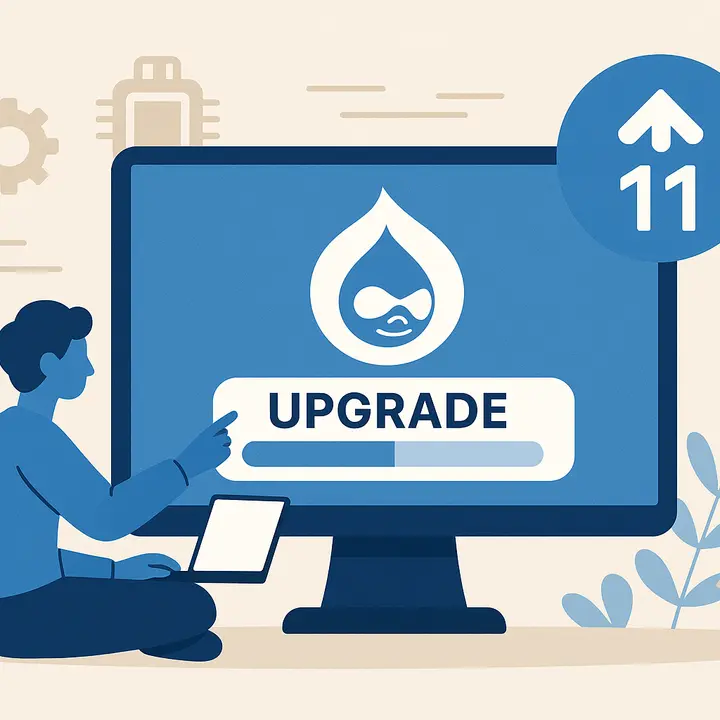Un aperçu rapide du taux de rebond
Le taux de rebond est le pourcentage de sessions sur votre site web au cours desquelles l'utilisateur ne consulte qu'une seule page avant de quitter. Si votre modèle commercial ne repose pas sur le fait que les utilisateurs consultent uniquement la page d'accueil, alors un taux de rebond élevé pose problème. C'est un indicateur clair que les utilisateurs quittent votre site web peu après leur arrivée. Par conséquent, vous pouvez considérer le taux de rebond comme un indicateur de la satisfaction client après leur interaction avec votre site web.
5 raisons pour lesquelles les utilisateurs quittent votre site Drupal
Si le taux de rebond de votre site Drupal est élevé, une enquête plus approfondie est nécessaire. Ci-dessous, les spécialistes de Drupfan décrivent les raisons les plus courantes pour lesquelles les gens quittent un site web.
Chargement lent des pages web
Quelle est une bonne vitesse de chargement d'une page web ? Un temps de chargement de 2 secondes ou moins est recommandé. Les recherches montrent que les utilisateurs quittent un site qui prend plus de 4 secondes à charger. Idéalement, une page web devrait se charger en un clin d'œil — 0,4 seconde ou moins. Chaque milliseconde de retard réduit les taux de satisfaction des clients, ce qui peut les amener à abandonner le site à jamais. En conséquence, les taux de conversion diminuent également.
Dans un sens plus large, la performance d'un site Drupal ne se limite pas à la vitesse de chargement des pages, mais inclut également la vitesse de chargement des médias, la capacité globale du site à gérer les requêtes et le trafic des utilisateurs. Pour améliorer les performances globales du site, tous ces aspects doivent être pris en compte.
Le meilleur outil pour auditer les performances d’un site web, tant pour le mobile que pour le bureau, est PageSpeed Insights. En plus d’analyser et d’évaluer les performances, PageSpeed Insights effectue un contrôle de l’accessibilité, du SEO et des bonnes pratiques du site, et fournit des conseils précieux pour résoudre les problèmes connexes.
Mauvaise optimisation SEO
L'optimisation pour les moteurs de recherche (SEO) est essentielle pour une stratégie commerciale en ligne réussie. Toutes les métadonnées, ainsi que les mots-clés et les descriptions, doivent être pertinentes et ne présenter que les informations essentielles. Si les métadonnées et les mots-clés sont mal définis et ne correspondent pas au contenu de la page, il n'est pas surprenant que les visiteurs quittent un site web après ne pas avoir trouvé ce qu'ils s'attendaient à voir.
De plus, tous les redirections doivent fonctionner correctement et mener à la page web attendue. Prenez le temps, chaque mois, de revoir le contenu, de vous assurer qu'il est toujours pertinent et à jour, et de vérifier les liens et les redirections pour détecter les erreurs 404, etc. Ainsi, vous vous assurez que votre SEO reste toujours performant.
Manque de réactivité mobile
De plus en plus d'utilisateurs choisissent les mobiles pour accéder à Internet. Le CMS Drupal est réputé pour son approche mobile-first en matière de développement web et constitue le meilleur choix pour créer une plateforme réactive. Dans Drupal, l'approche mobile-first se concentre sur la structuration du contenu, l'affichage des mises en page et le fonctionnement des fonctionnalités sur mobile.
Cependant, comme pour tout autre aspect du développement web, la réactivité mobile doit être ajustée et optimisée. En outre, il est crucial de créer un design web spécifique orienté mobile, car les éléments du site ne peuvent pas apparaître de la même manière sur un ordinateur de bureau et sur un mobile.
Le site web n’a pas de certificat HTTPS
Le certificat HTTPS est un certificat numérique qui confirme et authentifie le site et crée un environnement sûr et fiable pour tous les utilisateurs. Pour vérifier si un site utilise le protocole HTTPS, il suffit de regarder son URL : elle commencera par https://.
Le certificat HTTPS garantit que toutes les données de l'utilisateur sont cryptées et transmises via un réseau sécurisé. Par exemple, lorsqu'un utilisateur entre son identifiant et son mot de passe sur un site en https, ses identifiants sont cryptés pour les protéger des pirates ou des bots malveillants.
Voir un http:// dans l'URL sans la lettre "s" (https) signifie que le site n'utilise pas le protocole HTTPS. Ainsi, de nombreux visiteurs peuvent abandonner un tel site par souci de sécurité.
La navigation sur le site est peu claire
La navigation sur un site est un ensemble organisé de liens menant à d'autres pages de la plateforme. La navigation web doit être intuitive et mener au formulaire de conversion clé en un minimum de clics. Si la navigation est peu claire, mal visible ou comporte de multiples étapes jusqu'au point de destination, les utilisateurs sont plus susceptibles de quitter le site.
Conseils pour inciter les utilisateurs à rester plus longtemps sur votre site web
Voici les conseils essentiels pour empêcher les utilisateurs de quitter votre site Drupal.
- Publiez uniquement du contenu de haute qualité et pertinent.
- Évitez les titres accrocheurs trompeurs.
- Créez des boutons d'appel à l'action (CTA) attrayants avec des demandes claires.
- Rendez votre site accessible et conforme aux exigences WCAG.
- Assurez-vous que toutes les métadonnées et mots-clés sont pertinents par rapport au contenu de la page web.
- Supprimez tous les liens cassés ou redirections erronées.
- Améliorez les performances du site web. Assurez-vous que votre site réussit l'audit des Core Web Vitals de Google dans PageSpeed Insights.
- Rendez votre site Drupal réactif.
- Créez un design web convivial et intuitif.
- Utilisez des contenus multimédias.
- Ajoutez des éléments interactifs.
- Créez des expériences utilisateur personnalisées.
- Proposez des opportunités de retour d’information.
En suivant ces conseils simples, vous pouvez réduire considérablement le taux de rebond de votre site Drupal, tout en engageant davantage les utilisateurs et en augmentant leur niveau de satisfaction.
Conclusion
Bien qu’il puisse y avoir de multiples raisons pour lesquelles les utilisateurs quittent votre site Drupal, nous avons décrit dans cet article de blog les problèmes les plus courants : chargement lent des pages, données SEO non pertinentes, manque de réactivité mobile, absence de certificat HTTPS et navigation confuse.
Si vous rencontrez un taux de rebond élevé sur votre site Drupal et souhaitez explorer les raisons plus en détail, n’hésitez pas à contacter l’équipe Drupfan. Nos experts peuvent effectuer un audit approfondi pour déterminer ce qui pousse les visiteurs à quitter votre site. Après avoir identifié les points problématiques, nos professionnels Drupal amélioreront facilement les taux de rétention et la satisfaction globale des utilisateurs. Avec le soutien de Drupfan, vous pouvez transformer votre site Drupal en un environnement plus attrayant et convivial pour votre public cible.





